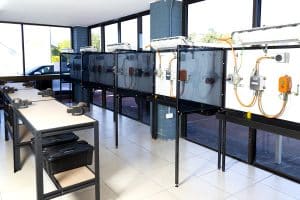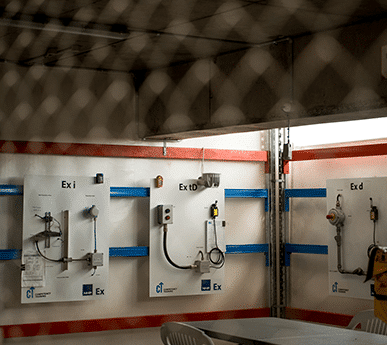The Best Guide To Roar Solutions
The Best Guide To Roar Solutions
Blog Article
Roar Solutions Fundamentals Explained
Table of ContentsRoar Solutions - An OverviewRumored Buzz on Roar SolutionsThe Ultimate Guide To Roar Solutions
In such an environment a fire or explosion is feasible when 3 basic problems are fulfilled. This is usually referred to as the "dangerous area" or "combustion" triangular. In order to safeguard setups from a potential surge a method of evaluating and identifying a possibly unsafe location is needed. The function of this is to guarantee the proper option and installation of equipment to ultimately stop a surge and to make certain security of life.
(https://au.enrollbusiness.com/BusinessProfile/7095102/ROAR%20Solutions)
No tools should be installed where the surface temperature of the equipment is more than the ignition temperature level of the given hazard. Below are some common dust dangerous and their minimum ignition temperature level. Coal Dirt 380C 225C Polythene 420C (melts) Methyl Cellulose 420C 320C Starch 460C 435C Flour 490C 340C Sugar 490C 460C Grain Dust 510C 300C Phenolic Material 530C > 450C Aluminium 590C > 450C PVC 700C > 450C Soot 810C 570C The probability of the danger existing in a focus high adequate to create an ignition will certainly differ from area to location.
Dangerous area electric tools perhaps created for use in greater ambient temperatures. Field Repair By Authorised Personnel: Complicated testing might not be called for nevertheless certain procedures may require to be adhered to in order for the devices to preserve its 3rd event score. Each piece of equipment with an unsafe rating must be evaluated independently.
How Roar Solutions can Save You Time, Stress, and Money.
The equipment register is a thorough database of tools records that consists of a minimum collection of areas to determine each item's area, technical parameters, Ex lover category, age, and environmental information. This information is critical for tracking and managing the devices effectively within unsafe areas. On the other hand, for regular or RBI tasting evaluations, the quality will be a mix of In-depth and Close evaluations. The proportion of Thorough to Shut inspections will certainly be determined by the Devices Threat, which is evaluated based on ignition danger (the probability of a source of ignition versus the probability of a combustible atmosphere )and the hazardous location category
( Zone 0, 1, or 2). This variation will certainly likewise affect the resourcing needs for work prep work. As soon as Lots are specified, you can create tasting plans based upon the sample size of each Great deal, which describes the variety of arbitrary devices products to be inspected. To determine the needed sample size, 2 facets need to be assessed: the size of the Great deal and the classification of assessment, which suggests the degree of initiative that must be used( decreased, typical, or increased )to the examination of the Lot. By combining the category of assessment with the Whole lot dimension, you can after that develop the proper being rejected standards for an example, indicating the allowed number of malfunctioning things discovered within that sample. For even more details on this procedure, please describe the Power Institute Standards. The IEC 60079 typical recommends visit that the maximum interval in between evaluations should not go beyond three years. EEHA assessments will likewise be carried out beyond RBI projects as part of arranged maintenance and tools overhauls or repair work. These examinations can be attributed towards the RBI sample sizes within the affected Great deals. EEHA evaluations are performed to determine faults in electric devices. A heavy racking up system is important, as a single tool may have numerous faults, each with differing degrees of ignition threat. If the mixed score of both examinations is much less than two times the mistake rating, the Lot is considered acceptable. If the Whole lot is still thought about undesirable, it needs to undergo a complete examination or reason, which might trigger more stringent inspection protocols. Accepted Lot: The sources of any type of faults are determined. If a common failing setting is located, additional tools might need maintenance. Mistakes are classified by severity( Safety, Honesty, Housekeeping ), making certain that immediate concerns are assessed and attended to promptly to alleviate any type of influence on safety or operations. The EEHA data source must track and videotape the lifecycle of faults along with the rehabilitative activities taken. Executing a durable Risk-Based Examination( RBI )method is critical for ensuring conformity and safety in taking care of Electric Tools in Hazardous Areas( EEHA) (Roar Solutions). Automated Mistake Scoring and Lifecycle Management: Easily take care of mistakes and track their lifecycle to enhance inspection accuracy. The introduction of this support for risk-based examination even more strengthens Inspectivity's setting as a best-in-class service for regulative conformity, along with for any asset-centric inspection usage instance. If you are interested in discovering more, we welcome you to ask for a presentation and discover just how our service can transform your EEHA administration processes.
The 30-Second Trick For Roar Solutions

In regards to explosive risk, an unsafe location is an atmosphere in which an eruptive environment is existing (or might be expected to be existing) in amounts that require special preventative measures for the building, setup and use tools. eeha training. In this write-up we discover the obstacles dealt with in the workplace, the risk control actions, and the needed expertises to work securely
These materials can, in particular problems, develop explosive ambiences and these can have significant and tragic repercussions. Many of us are acquainted with the fire triangular remove any one of the three elements and the fire can not happen, however what does this mean in the context of harmful areas?
In a lot of circumstances, we can do little concerning the levels of oxygen airborne, yet we can have substantial influence on resources of ignition, as an example electric tools. Dangerous areas are documented on the dangerous area classification drawing and are identified on-site by the triangular "EX" sign. Here, amongst other key info, zones are divided into three types depending on the hazard, the likelihood and period that an explosive environment will exist; Zone 0 or 20 is regarded one of the most unsafe and Area 2 or 22 is deemed the least.
Report this page